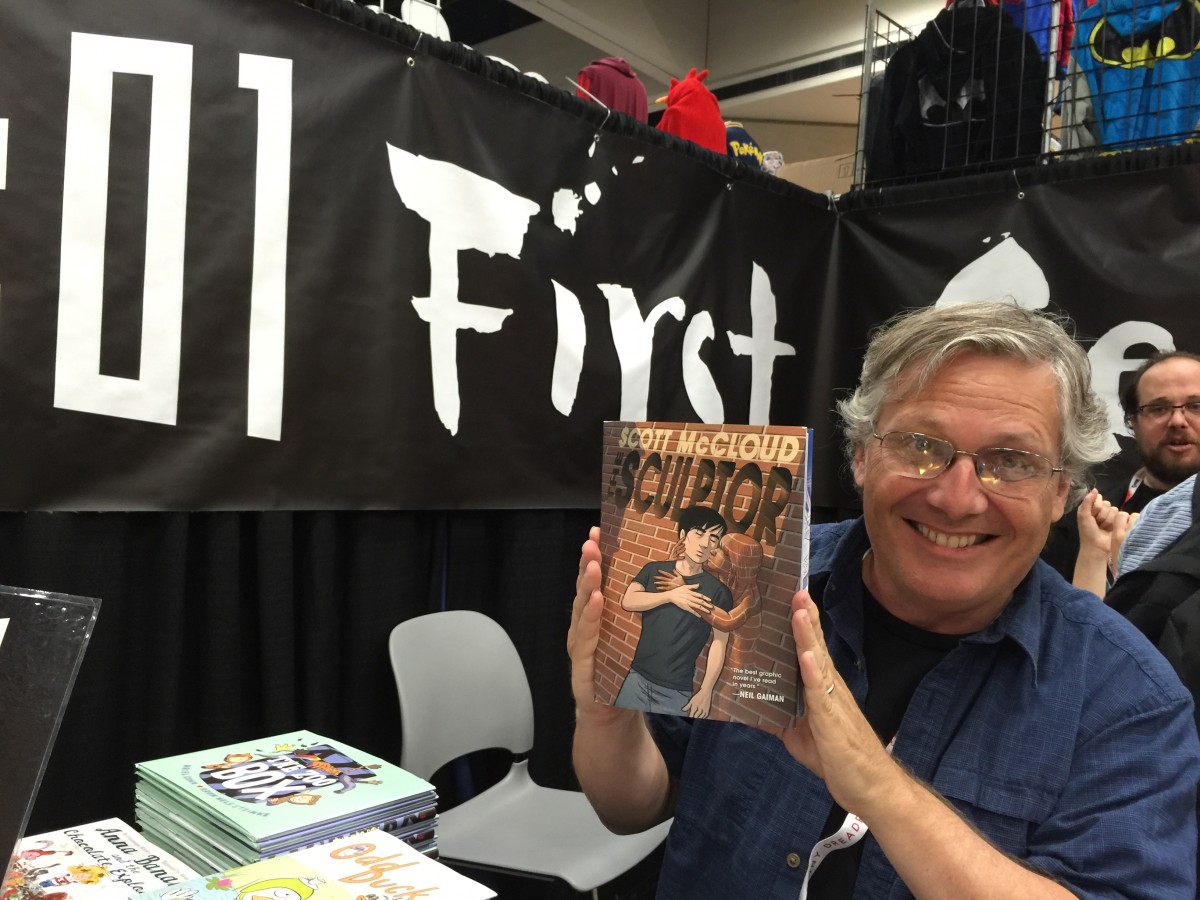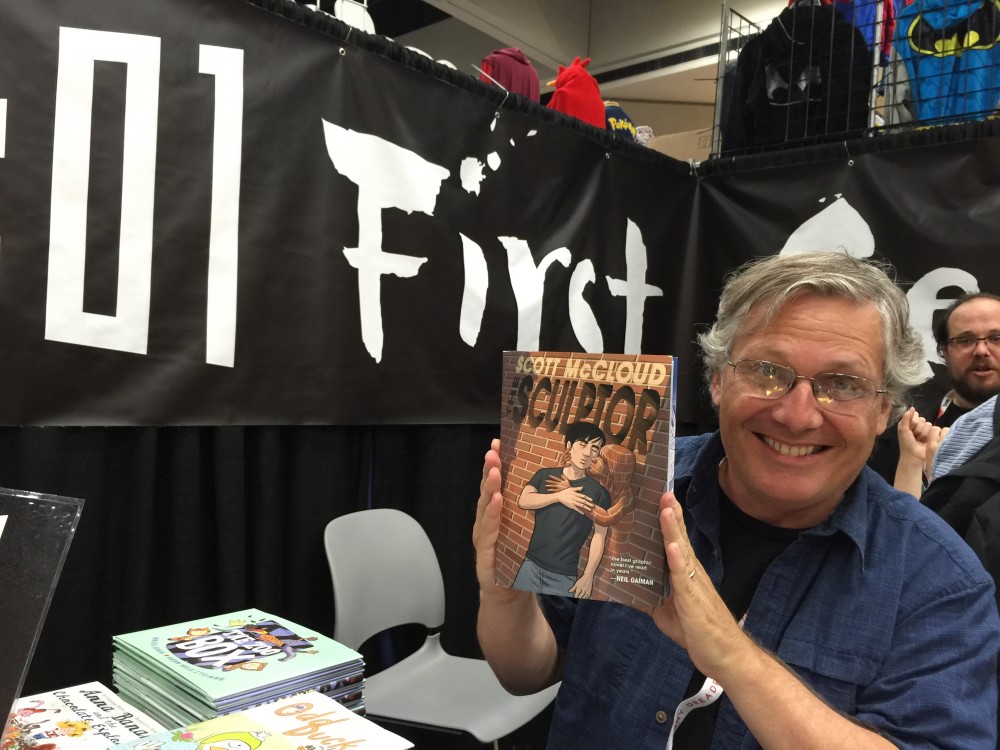
By Victor Van Scoit
At San Diego Comic-Con I had a chance to sit with Scott McCloud where we talked about industry changes and how storytelling has changed as our world has gotten smaller, creative anxieties and mindful awareness, the art of visual communication, and how that all influenced his latest book The Sculptor.
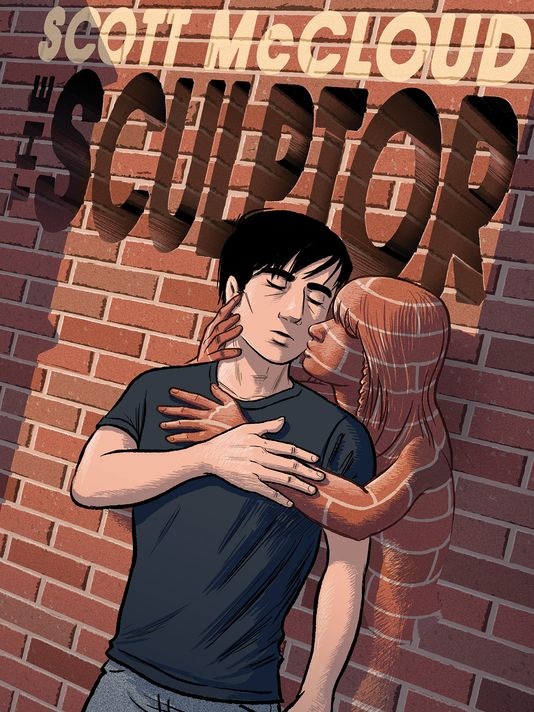
Victor Van Scoit: To start anecdotally, the last time I got to speak with you I attended your workshop. It was in L.A. and I was in the workshop that had what I believed was a normal class size. We had 12 people.
Scott McCloud: Oh yeah. That was the little one. Yeah, yeah I remember that—
VV: It was really interesting because you said how that was oddly a small class size. Normally you’re used to around 30 people. Also we only had one or two women.
SM: Yeah usually it’s pretty balanced these days.
VV: That’s one of the things I wanted to mention. Around ten years ago I remember seeing you speak in Texas and you’d mentioned you were really looking forward to this convergence. What you expected to happen with Western storytelling and this manga influence that these young boys and girls were getting that would eventually grow up to be creators.
SM: Especially the girls. Those girls, sitting cross legged in Barnes & Noble reading Fruits Basket and all. Yeah I had this prediction.
VV: And we’re seeing it! I mean I think we are.
SM: Yeah! We’re going to pass 50 percent pretty soon. It’s going to be a majority female industry.
VV: I think it’s been real great just to see the convergence of also the storytelling. You’re working with First Second and one of the books I think of is Last Man over from France which has this great mixture. What’s it been like for you? You’re not the type of person to say I told you so, but it’s got to make you feel good to see that you’re reading the vibe correctly.
SM: [laughs] In this one case I’ll definitely do an “I told you so” just because I sort of laid an informal bet about that majority female industry. I marked it as 2024 so I’ll definitely crow a little if I was right about that one.
VV:I think you’re on point.
SM: The readership is already approaching 50/50 but we want to get the industry and the output of the industry also lined up as well. We want to have just as many female characters for example. I’ll definitely do a little Snoopy dance if I get that one right. That’s a nice long term prediction to make.
But manga was definitely an important part of that. And that manga boom was a fascinating Big Bang for that phenomenon. You know at a certain point about 15-20 years ago it occurred to me that of these three big nations of comics—I think of them as The North American tradition, the Japanese tradition, and the Franco-Belgian tradition which spread out over Asia, Europe and North America—each one had its own way of looking at comics. And the important thing with manga was making you feel like you were part of the story. And the important thing with the European tradition was world building. I thought it would be real cool to put those two together, and I was trying to do that with the latest graphic novel. It’s very strongly in the manga tradition but also has a really heavy world building feeling to it too. Like New York is almost a character in the book. It’s a very international book that way.
What’s funny is that if you look at Japan in the 90s and the 2000s you start to see the European influence coming over. You start to see manga artists influenced by European artists. And sure enough who do we think of when we think of that internationalist theme? We think of [Hayao] Miyazaki and we think of [Katsuhiro] Otomo, right? And what both of them have in common compared to a lot of their manga contemporaries is that they were world builders. They were incredibly obsessive world builders. They took the time to draw every last little little part of their world.
VV: I’m glad you mentioned how you approached that in The Sculptor. That’s one of the things I was interested in. We started talking about how young kids are going to be influenced by this convergence and that’s subconsciously driven. But how did you approach it more consciously and take steps to bring those two storytelling worlds together?
SM: Well it was easy for me because I got a head start. Back in the early 80s I was working at DC Comics. This is 1982. I got a job at DC Comics in Manhattan right out of college. In fact I got the job three weeks before I left college. DC Comics was in Rockefeller Center and they were three blocks away from Books Kinokuniya, the biggest Japanese bookstore in all of Manhattan, and the whole second floor was comics.
VV: I love that bookstore because of that.
SM: And they didn’t shrink wrap the fuckers.
VV: [laughs]
SM: They did not shrink wrap them. So I could go on my lunch hour. I’d get either a hot dog, or a knish on the street, or I’d bring a sandwich. But the point is lunch lasted four or five minutes for me, and then boom I was out the door and I would spend the rest of that hour stand reading. This is something Japanese businessmen did, is they would just stand on their lunch hour and read their comics. Just stand. Read. Stand and read right in the shop and that’s what I did. I bought a lot of them but I read many, many more. That’s when I discovered all these techniques. It took me a while to sort of list all these techniques that they were doing in Japan but not here. There was a point, a kind of eureka moment where I saw that they were all essentially the same idea. Which was making you feel that you were in the story instead of watching it. Making you feel like a participant instead of an observer. Make you feel like instead of watching a character move across the scene, you were the one doing the moving. You were the one experiencing the emotion. You were the one absorbing all of the sensations in your environment. That’s the Japanese way. There may be no coincidence that Japanese comics were 30 times as popular as in North America, twice as popular as in Europe. That was all a long time ago and I incorporated it into Zot! and I incorporated those ideas into Understanding Comics so in a lot of ways it’s been with me for so long that it came naturally. It was actually a very natural thing.
VV: I remember reading it in your comics but especially began to see it in some of the mainstream comics that thing that Japanese manga and animation has always been real good at is taking the moment to pause. Slowing the clock down. Having empty frames in there. I noticed from a pacing perspective in The Sculptor you’re definitely doing that. There were also portions that I would just zoom through.
SM: Oh yeah. People read that book very fast, often in one sitting, despite the 500 pages it can clock in at two or three hours.
VV: It seems daunting at first, but I killed it all at once. Is that a common occurrence that you’re hearing?
SM: Extremely common. It’s almost a cliche now that when I talk to somebody about The Sculptor chances are one-in-two that I’ll find out that they read it in one sitting.
VV: Do you think maybe it’s because it’s playing a movie in their head?
SM: It’s definitely cinematic. It definitely has that narrative momentum, but it also has that sense of participation. So if I’ve done my job right you should feel like you’re there because of those Japanese techniques. And you should feel like the world is a rich, sensory environment because of that European approach. That can create a kind of traction, a kind of friction, where you just want to know what happens on the next page. You know? All you have to do—it’s very simple like a binary thing—all I have to do is on any given page make you want to read the next page. If I can just do that every page—I’m done. You’re going to keep going
VV: I like how in the book there’s a few panels that feed literally into that. The panel transitions into the next page. Like you’re purposely doing that.
SM: Yeah like my hand—I’m grabbing your hand and turning that thing. Time is so important in this book. We’ve got a character who has 200 days to live, and that idea of slowing the clock becomes front and center. Towards the end of the story without giving too much away, there’s a moment where the ticking of the clock becomes like this really loud feeling and you just want to reach up and just stop the hands of the clock. I’m talking about a sequence which is a series of full page spreads one after another, after another, where barely a fraction of a second is going by but you have these huge images. What I’m essentially trying to do even as you’re paging through the thing and going very fast you’re also, I hope, experiencing that sensation of the whole world slowing down and the desire to stop time from proceeding. Because comics is such a temporal medium. Because it’s so much about the passage of time in a spatial medium. That to me is very comics. Even though I tried to create a story where you wouldn’t be thinking about all the formal stuff. It’s still there. It still has its voice.
VV: Those full page spreads you’re talking about I imagine you hope people stop and take in everything that’s going on
SM: I know they’ll flip by them fast. [laughs]
VV: But if they do stop and allow for that decompression of time… it makes me think of a study that came out recently that one of the best way to remove the anxiety of life and time slipping by is to have a moment of awe for the day. Whether it’s seeing a great movie, beautiful artwork, or a beautiful sunset apparently it shows that that moment of awe can let you decompress time a little bit and make it seem a little less imposing.
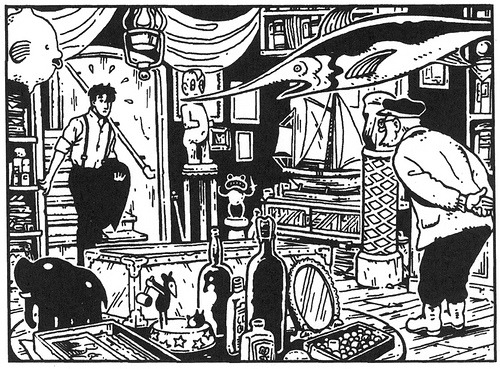
SM: This is what I call narrative density. There are tiny little panels that I’ve stared at for a really long time because there was so much to see. There was so much information in them. Not detail, not just lots and lots of lines and lots and lots of objects. But objects and details that had presence, that had meaning, that had some kind of narrative density. There’s a little panel in a book called Jar of Fools by Jason Lutes that came out back in ‘94. I stared for a really long time at this panel because all it was was the room of the protagonist. The protagonist comes home to his room and there were so many details in that room that told you about the protagonist – an empty birdcage, a bare lightbulb, bars on the windows, lots of liquor bottles over a bare sink. There was so much that was telling you about him that it slowed you down. But that whole thing was no bigger, the actual panel, was barely bigger than your thumb. But it had narrative density. What you’re just describing, that idea of what slows down the clock for us—also things like mindful experiences during the day. I’m a great believer in mindful eating. You put your feet flat on the floor, if you can if you’re not too short like my wife, and you let your whole body relax and enjoy the sensation of the food and think about the sensation of the food. I like that slow process to kinda happen with comics too.
VV: I think that awareness is key. Even touching back to The Sculptor that’s kind of what David is learning.
SM: Yeah. That’s exactly what he’s learning.
VV: I remember thinking that I really liked, I don’t think is spoiling anything, but when he gets the power to create whatever he wants his first result isn’t that great.
SM: No no. [laughs] It’s a failure!
VV: Yes you can do something amazing, but ultimately if you’re not creating art from a good place it still might be less than.
SM: Right, exactly. Getting all of your external obstacles taken care of is not necessarily going to solve your internal obstacles. And yeah it doesn’t solve his problems at all. Because he doesn’t have whatever it takes inside him to make this work is still not there. Now he comes up against the ultimate obstacle himself. That’s a much, much bigger wall to climb than he thought it was going to be.
VV: Yes there’s a couple themes in here. Whether it’s identity, anxiety of creative expression, but a really great one is that even some of my friends who are creators they can be amazing with what they’re doing but there’s always that little devil inside that makes them question it.
SM: Everybody has that. Absolutely.
VV: The story, there’s Meg, she kind of helps him get past some of those obstacles but because of that clock going away from him he’s, “Agh I finally found that thing!”
SM: Yeah as the clock gets faster and faster for him in terms of his work, she is helping to slow the clock. She’s helping to slow him down. Gradually he finds ways to slow himself down. It’s like you’re trying to slow your heart beat. You’re trying to place yourself almost in a state of suspended animation. One thing that we have to remember about this story is that this is a story about a guy who only has so many days to live and has to make the most of them. That’s not a fantasy.
VV: [laughs]
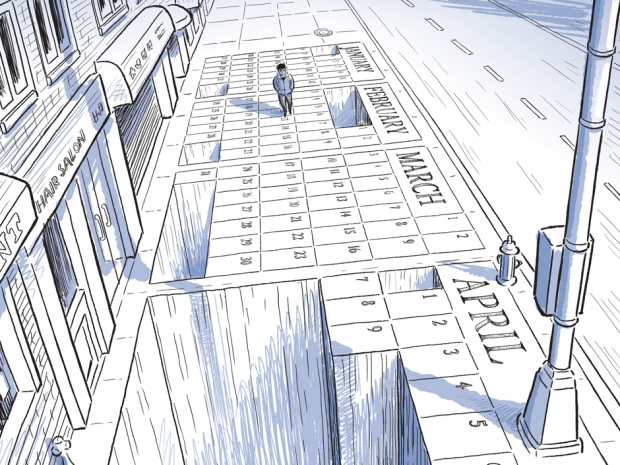
SM: That just happens to be the truth. The actual fact of life for every single one of us—all of us have a limited number of days. It doesn’t matter whether we know the number or not.
VV: I can imagine how that must’ve been frustrating for you because I know how you like to take time with your work. Not because you’re slow—
SM: I’m pretty slow
VV: —but because you put a lot of thought and process.
SM: I’m also slow. [laughs]
VV: Well I’ve seen examples of all your Photoshop layers and thumbnails and the way you plan it all out. For each page as you drew that wasn’t finished you kept imagining that clock yourself.
SM: Oh yeah. Oh man. It was there. It was originally going to be a three year project. It turned into a five year project, and that was 11 hours a day, seven days a week
VV: The book [The Sculptor] has been out roughly now six months and you know the story you intended to tell and get across, but have there been any angles or surprises you’re hearing about that people are getting from the book that you didn’t expect?
SM: I wouldn’t say it’s a surprise because it was part of my basic intention but it has been actually gratifying to find out how many people read it straight through. It’s that common that it’s kind of funny now how I hear it almost every single time. [laughs]
So many people just plowed through that thing. Hearing about people who it kind of broke or who were grateful for something that sounds extremely painful and awful. People will describe it—Wil Wheaton talked about it, I forgot what he said exactly, but it was essentially like he had been beaten to within an inch of his life by a brutal gang. He didn’t use those words exactly. It sounded like a wounding experience. But it’s like people are ready for that. It was interesting people seem to be ready or even grateful for any work of art, any kind of story that can physically assault them. That makes them actually feel. That actually raises bruises. I guess that doesn’t happen very often.
VV: Or even confront certain things that they’re not prepared for, much like David has to deal with himself as an obstacle sometimes the right story comes along and asks the questions you really don’t want to answer.
SM: Well I’ve heard from a few people who found it disturbing how much of themselves they saw in David. I have a lot of affection for David. I don’t see it as such a hell to be him. But a lot of people found that the fact that they had a connection with that character they found disturbing. They found it a real challenge to themselves.
VV: This might sound strange, but you mention affection for David, which many others likely have. Yet in reality to start out with he’s not exactly the most likable.
SM: Oh he’s kind of a dick to be sure. [laughs] In fact he was even more of a dick in the earlier drafts. I just couldn’t go all the way towards dick. But there’s been stories of dicks before that people have related to. Even MacBeth if done right has some kind of bridge to our common shared sense of humanity. And that was the challenge for me, for David not to be the other in the eyes of the reader even as he was this prickly, arrogant, self-obsessed, narcissistic sort of a character. There had to be something about him that you could build a bridge to and I hope that I was able to do that for most readers to find some kind of emotional bridge. I also do have great admiration for his perseverance, for his honesty, for his willingness to adhere to these ridiculous promises he makes to himself. You know it’s a kind of virtue. At least he keeps his promises. [laughs] Again I do have that affection. But it’s interesting, it’s not quite as simple as that there’s a level of obnoxiousness that readers will not go beyond. You can be horrible. You can be Hannibal Lecter for God’s sake. You can be Walter White in Breaking Bad and people will still find some kind of a connection to [the character]. It’s an interesting formula. There’s a bit of alchemy to the creation of a character that you can identify with even as you find them detestable.
VV: I guess when it comes to yourself people love to identify you as the educational, almost a mentor in the comics world. You’ve finished The Sculptor. You’re now spreading the word and marketing it, but do people have to worry about you leaving that behind—that educational side of you? It’s seems like such a part of you I would almost find it impossible to stop.
SM: [laughs] Well there’s no danger in my completely stopping pontificating. My next book in nonfiction and it’s going to be about visual communication. Not about comics specifically, although comics is in the mix, but I want to talk about the way that we communicate with and learn from images
VV: Visual communication sounds perfect because maybe once again you’re on that rising tide or cusp moment of identifying into words what people feel. That “Oh! That’s why I consume these things that way” or “That’s why I enjoy this thing this way”.
SM: Right which was a phenomenon with Understanding Comics. A lot of people felt that was that little voice in their head finally giving word to something that they already were experiencing—that they already understood on some level. That is something I’d like to bring to the subject in visual communication.
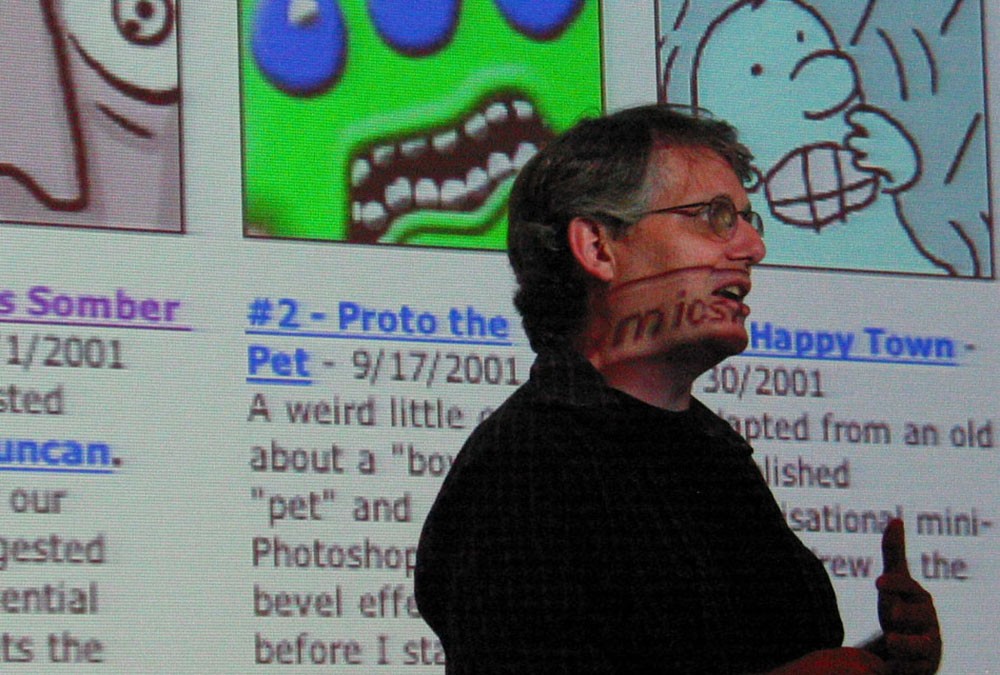
VV: I hope so. One of the things I really loved from your workshop, reading your books, and hearing you speak is that idea of cognitive load. That conjoined with the potential for educational side of comics or any graphic medium or storytelling. People worried in the early days with graphic novels whether it was good for kids to learn from because sometimes there’s not as many words, but there’s sometimes so much more to deal with [compared to a book]. You mentioned that with Jar of Fools in that you’re taxing the brain in multiple ways even if there’s not as many words.
SM: Oh absolutely.
VV: Is that one of the focuses?
SM: That’s part of it, yes. I’m interested in everything from picture books to presentation—the philosophies that people have of presenting in PowerPoint and Keynote—and of course like data visualization, information graphics, nonfiction comics, animation. All of the different ways that we set out to communicate and then all of the ways that we communicate almost without meaning to.
VV: So this book will extend past the comic books format?
SM: Well I have to go—I have to stay true to my religion that comics can communicate anything. It’ll still be comics but it’s not going to be quite like Understanding Comics or Making Comics. It won’t stay within the panel. It’s going to be probably more graphically bold. But there will still be the narrator. I’ll still have the guy in the check jacket, getting ever fatter with slightly whiter hair, will be there explaining things.
VV: Hopefully it will touch people the same way Understanding Comics or Making Comics did to create, but from a presentation standpoint alone it seems like it could be the perfect thing to hand someone if they need to do a TED-like talk.
SM: That’s part of it actually. My philosophy of presentation is that something where I’ve actually been doing it [long enough] now that I’ve developed some pretty strong ideas. That’ll be part of it.
VV: If nobody has seen you speak before I highly recommend to do so. For my take it’s a way of getting a lot of information and sometimes not even realizing how much you process. Because you don’t use bulleted lists, few words, and the graphics once again bring in that cognitive load of taking in multiple items at once. Without even taking notes, afterwards being surprised at how much is retained.
SM: Thank you. I think that those dynamics that you just listed are in fact present in a lot of other disciplines. And that’s one of the reasons why it was exciting to me to tackle this as a book. I realized that, “Oh you know what?” people in presentations are knocking on some of the same doors that the people in data visualizations are, people in information graphics are, even the people who study facial expressions and body language a lot of them are looking at the same core principles and trying to reinvent the wheel. I want to see if I can find out what those principles are, the ones that run across all of those disciplines simultaneously. Are there a few fundamental core truths about the way we learn with pictures.
VV: I think it’ll be great. Outside of The Sculptor and your other books where can people potentially get to see some more of you? Are you doing any tours?
SM: I’m still doing speaking gigs with a busy fall coming up. You can find that just at scottmcloud.com in the sidebar. Though I have to update that sidebar because it’s clogged with the 100 straight days of touring we did in the U.S. and seven european countries. I always do lectures around the country and you’ll always find them at scottmccloud.com right there on the front page.
VV: Oh! One last question before it leaves me. One of the things that I appreciate about [your approach] and others like Gene [Luen Yang] is that you’re creators but you come at it from a—I think Gene mentioned it last year at a panel when people talk about the conflicted artist. He comes at it from almost a left brain scenario of not understanding that conflict. Just draw. It’s just like engineering. Just get it done. So it’s really nice to see both your approaches to be able to analyze.
SM: Well Gene and I—we’re a particular tribe. Gene and I are both I believe are the sons of engineers. I think his dad was an engineer too like mine. I could be wrong about that part. We’ll fact check that. (VV: Gene’s dad was indeed an electrical engineer)
VV: I just want people to know that you don’t have to be “Mr. Emotional” to be a creator.
SM: You don’t. You don’t. But I think for those who have a kind of emotional altitude over things—like Gene and I who like to analyze and that have a pretty sunny disposition—we do create certain types of work. We’re part of the ecosystem. What we can bring to the medium is one thing, and then what other people who maybe have that darker disposition they bring a different perspective to the work that’s equally vital, equally important. A lot of very conflicted, very dark, very sort of inarticulate artists have created some of the most lasting works. It’s like any ecosystem. You want all those tribes working simultaneously. We’re sort of in the teachers, the research and development wing, and the tinkerers—those guys—we serve a particular role in this ecosystem.
VV: I know it made me feel better because when I took your workshop I no longer have any artistic ability whatsoever by comparison to some of these professionals. It was reassuring that I could take your class having none of that, but could still take a lot from a learning perspective or if I did want to create how best to communicate ideas with an artist. So I think you’re doing great work on that side of the house.
SM: That’s wonderful to hear. Thank you Victor.
VV: Thanks for your time. We really appreciate it.
SM: My pleasure. This was fun.
Scott McCloud is a comic book creator best known for his work Zot!, theoretical and educational books Understanding Comics Reinventing Comics, and Making Comics, and most recently The Sculptor published by First Second Books and available now..


